

The DXZone: ham-radio, shortwave and cb-radio guide. Marine, Aeronautical and Coast Station Radio Officers. Important Events in Radiotelegraphy: February 1, 1916. Ham Radio History. A year or so after QST first began its International Amateur Radio department, amateurs were discussing linking amateur radio organizations around the world.
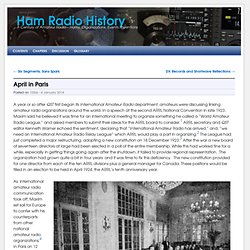
In a speech at the second ARRL National Convention in late 1923, Maxim said he believed it was time for an international meeting to organize something he called a “World Amateur Radio League,” and asked members to submit their ideas for the ARRL board to consider. ARRL secretary and QST editor Kenneth Warner echoed the sentiment, declaring that “International Amateur Radio has arrived,” and, “we need an International Amateur Radio Relay League” which ARRL would play a part in organizing.
The League had just completed a major restructuring, adopting a new constitution on 18 December 1923. After the war a new board of seventeen directors at large had been elected in a poll of the entire membership. Paris Dinner Meeting, 12 March 1924. First IARU Congress, Paris, 1925. As first IARU member, Maxim hands his dues to Warner. De W2PA. U-Boats, Spies, And White Magic: The Invention Of Wireless Cryptography. The wireless telegraph station in Sayville, New York was one of the most powerful in the world.
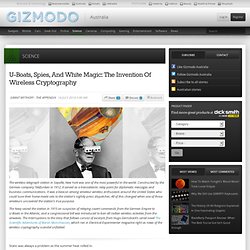
Constructed by the German company Telefunken in 1912, it served as a transatlantic relay point for diplomatic messages and business communications. It was a beacon among amateur wireless enthusiasts around the United States who could tune their home-made sets to the station’s nightly press dispatches. The Great Easter 1913 Flood: Wireless to the Rescue! Birth of Emergency Radio.
Not only was 2013 the centennial of the 1913 flood, but also of the birth of emergency radio.
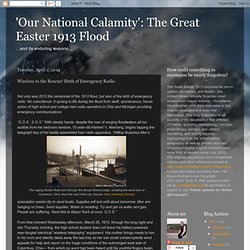
No coincidence: It sprang to life during the flood from swift, spontaneous, heroic action of high school and college ham radio operators in Ohio and Michigan providing emergency communications “S.O.S. S.O.S.” With steady hands, despite the roar of surging floodwaters all too audible from his bedroom window, 15-year-old Herbert V. Akerberg, begins tapping the telegraph key of his hastily assembled ham radio apparatus. Association wants city to send boats. From that moment Wednesday afternoon, March 26, 1913, through the long night and into Thursday morning, the high school student does not leave his battery-powered new-fangled electrical “wireless telegraphy” equipment. CQD. CQD, transmitted in Morse code as – · – · – – · – – · · is one of the first distress signals adopted for radio use.
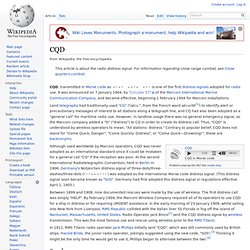
It was announced on 7 January 1904, by "Circular 57" of the Marconi International Marine Communication Company, and became effective, beginning 1 February 1904 for Marconi installations. Although used worldwide by Marconi operators, CQD was never adopted as an international standard since it could be mistaken for a general call "CQ" if the reception was poor. At the second International Radiotelegraphic Convention, held in Berlin in 1906, Germany's Notzeichen distress signal of three-dots/three-dashes/three-dots (· · · – – – · · · ) was adopted as the international Morse code distress signal. (This distress signal soon became known as "SOS". Germany had first adopted this distress signal in regulations effective April 1, 1905.) See also[edit] References[edit] Bibliography[edit] External links[edit] "C Q D" by Alfred M.
Titanic’s Fate Sealed That Of Broadcasting. Prior to the tragedy 100 years ago, wireless communications in the U.S was close to anarchy.

There wasn't much public sentiment for regulating a technology that few fully understood or that was as intangible as the "airwaves. " But the upshot of the disaster was a universal call for government regulation of wireless in the progressive spirit of the day. Wireless was clearly too important now to be left solely to the vicissitudes of free enterprise. The regulation carried over to broadcasting a decade later. So when you’re filling out renewal forms or pondering the fate of your spectrum, you can blame that damn iceburg.
Later this month, the FCC is likely to heap another regulatory chore on broadcasters — the requirement to post their public inspection file online. So whom or what do fed-up station managers blame for the new imposition on their operating budgets? Radio to the Rescue: David Sarnoff and the Titanic Disaster. From April 12 through May 11, 2012, a special exhibition of artifacts from The Sarnoff Collection was presented in the TCNJ Library to commemorate the 100th anniversary of the sinking of the Titanic, an event in which David Sarnoff played a significant role.
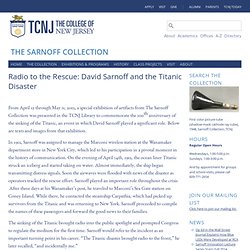
Below are texts and images from that exhibition. HOME PAGE: American Radio History library and Archive.Publications and documents about Radio TV and FM broadcasting. Www.americanradiohistory.com/Archive-Stevenson-Burgess-Others/Federal Radio Act 1927.pdf. The Radio Act of 1927 as a Product of Progressivism. Volume 2, Number 2 By Mark Goodman Mississippi State University ABSTRACTCongress passed the Radio Act of 1927 to bring order to the chaos of radio broadcasting.
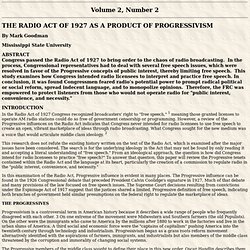
In the process, Congressional representatives had to deal with several free speech issues, which were resolved in favor of the Progressive concepts of public interest, thereby limiting free speech. This study examines how Congress intended radio licensees to interpret and practice free speech. INTRODUCTIONIn the Radio Act of 1927 Congress recognized broadcasters' right to "free speech," 1 meaning those granted licenses to operate AM radio stations could do so free of government censorship or programming.